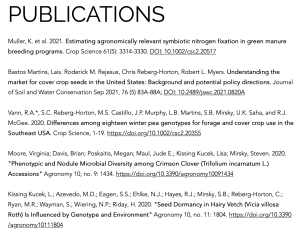
Why breed legume cover crops
Although they offer many benefits, legume cover crops can be variable in performance. Management constraints and poorly performing germplasm are contributing factors. Unlike cash crops, cover crops have not been bred to optimize the traits that farmers need, particularly for specific regions of the United States. This deficiency means that modest investments in germplasm improvement could yield large benefits; thus we are taking advantage of this opportunity to improve legume cover crops through a multi-site project across the US.
The ideal legume cover crop provides valuable ecosystem services, such as nitrogen scavenging and fixation, reduced erosion, improved soil health, weed suppression, and the provision of habitat and resources for beneficial organisms such as pollinators. When optimized, cover crops can help address critical challenges to agricultural productivity, like adaptation to and mitigation against climate change, bolstering no-till agriculture in the face of multiple-herbicide resistant weeds, and minimizing nutrient loading in our water supply.

Cover Crop Survey
To help inform our breeding efforts, we conducted a national survey of organic and conventional farmers to learn about what cover crop traits they thought were important. The top four traits chosen by respondents were: nitrogen fixation, winter hardiness, biomass production, and early vigor.
Cover Crop Breeding Network
From 2016 through 2022 our lab managed a research site as part of the Cover Crop Breeding Network (now the Moore Lab manages those trials). The goals of the Cover Crop Breeding Network are to improve cover crop genetics through traditional breeding methods, engage with farmers with participatory breeding, and assess advanced breeding lines for performance in different regions of the US. The legume crops of interest are hairy vetch (Vicia villosa), Austrian winter pea (Pisum sativum), and crimson clover (Trifolium incarnatum).














